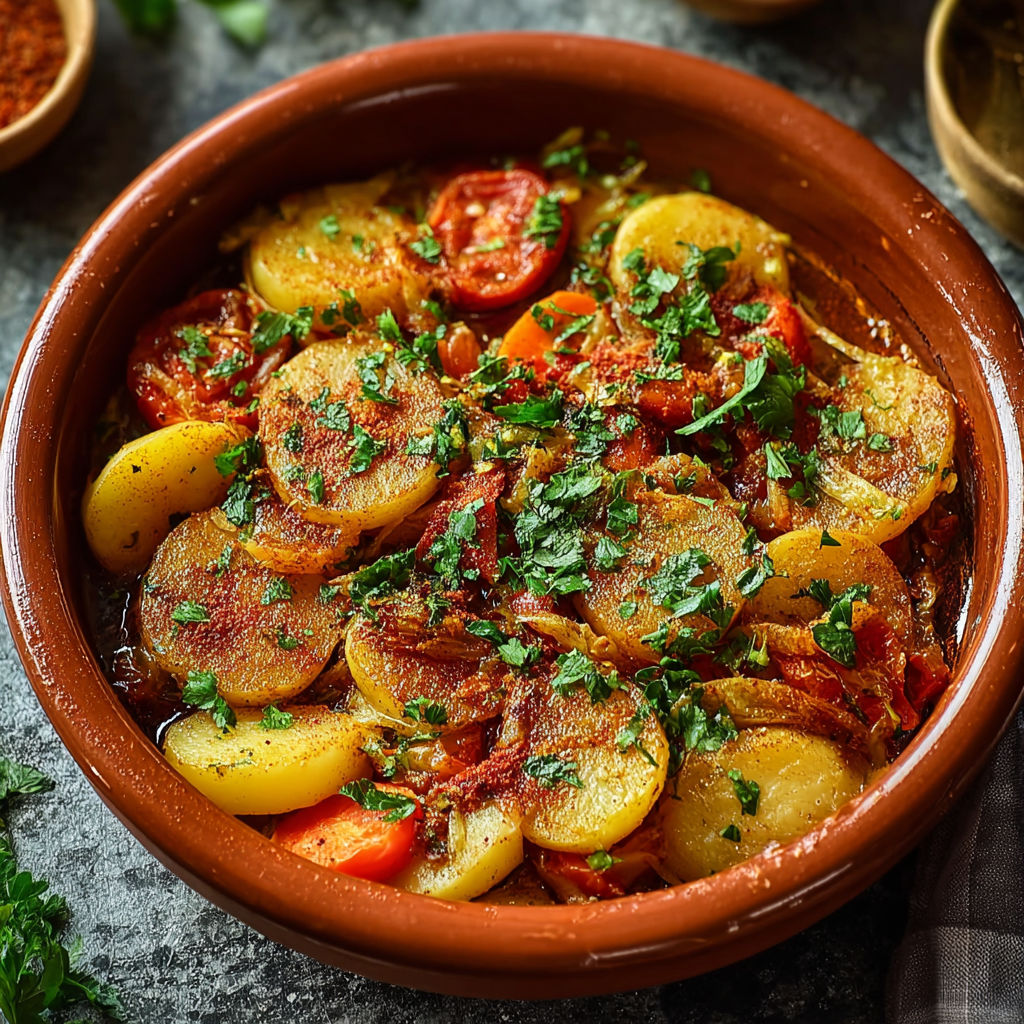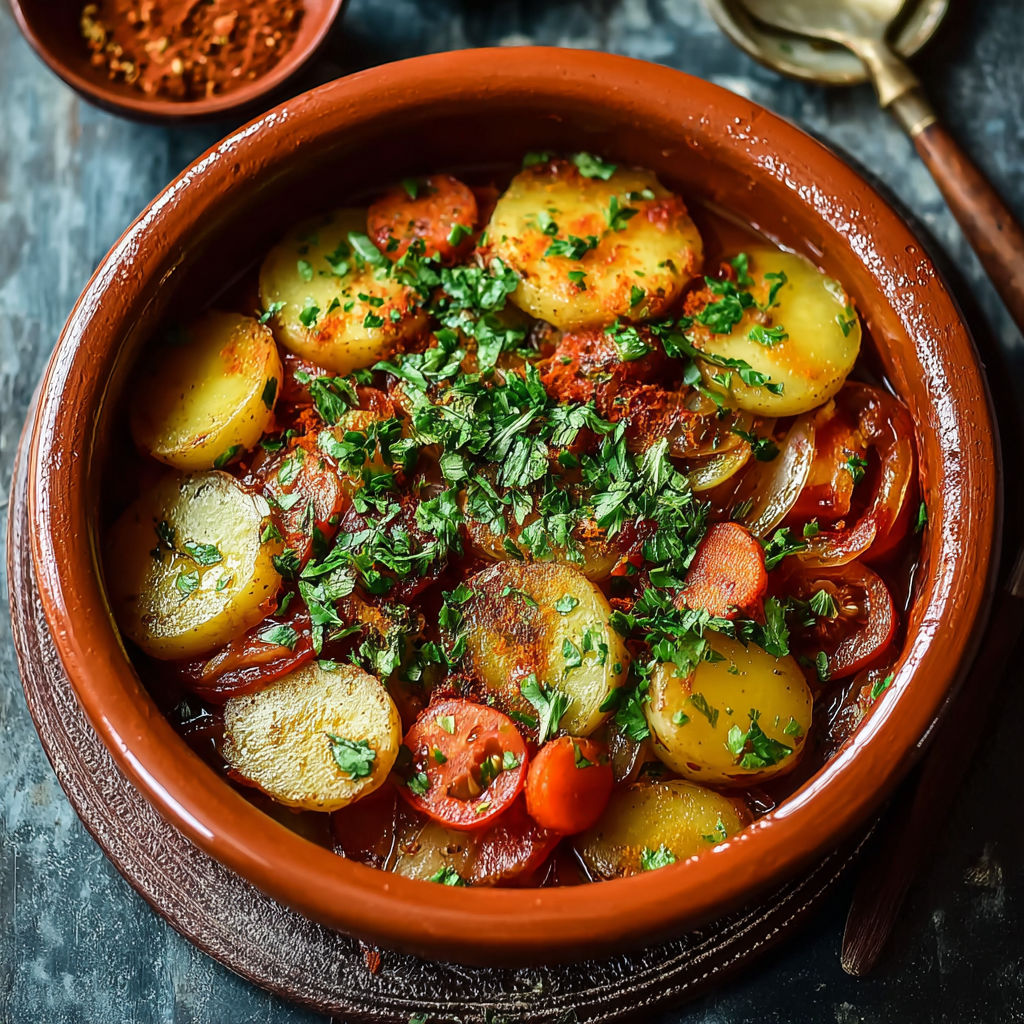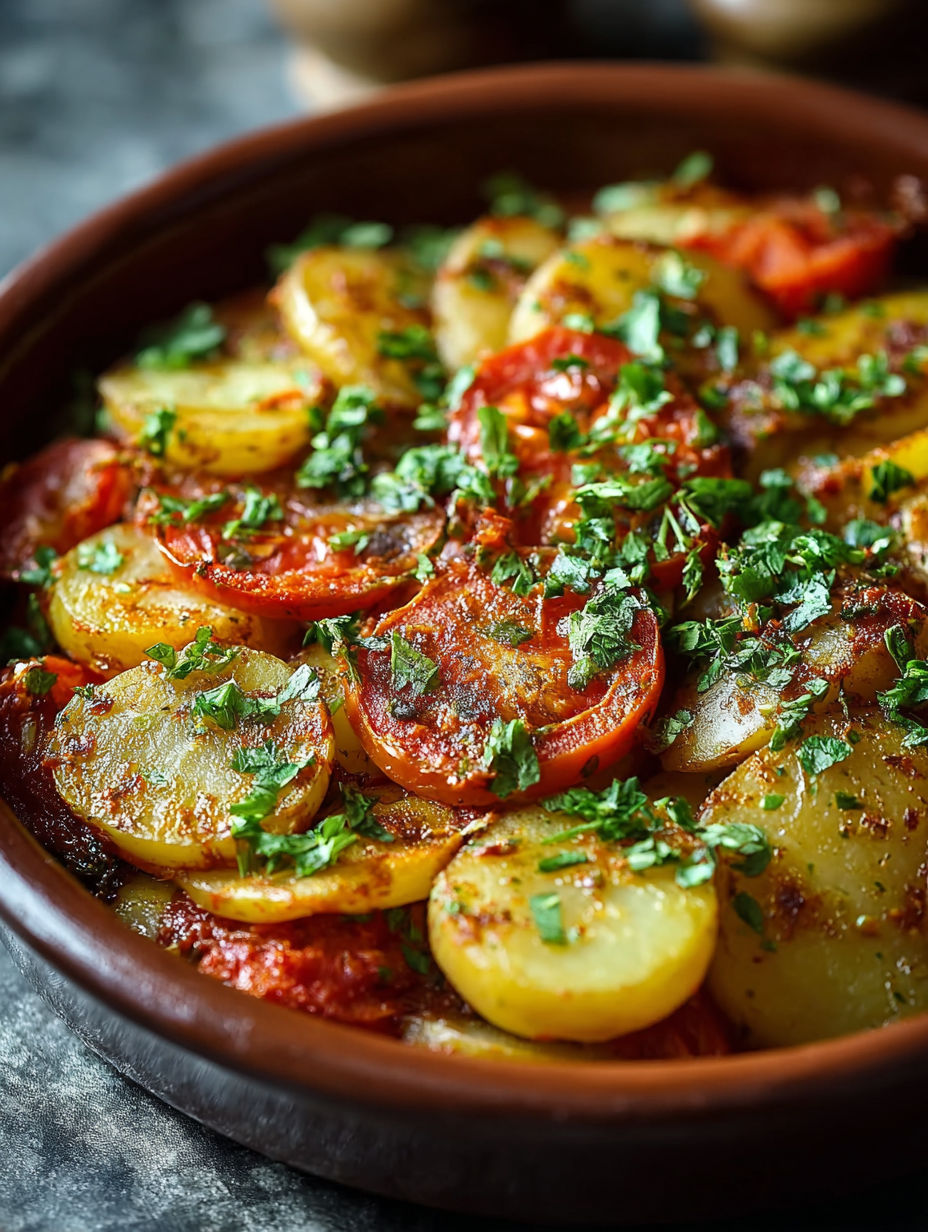 Pin
Pin
This aromatic Moroccan Potato Tagine transforms humble ingredients into a fragrant, melt-in-your-mouth dish that will transport your taste buds straight to Marrakech. The layered vegetables slowly cook until tender, absorbing the complex spice blend for a memorable vegetarian main course that requires minimal hands-on time.
I discovered this recipe during my exploration of North African cuisine and it quickly became my signature dish for dinner parties. The way guests' eyes light up when they taste the complex flavors from such simple ingredients never fails to bring me joy.
- Olive oil creates the base for the spice mixture and helps vegetables roast beautifully
- Harissa paste provides authentic Moroccan flavor with a gentle heat that builds gradually
- Ground coriander adds citrusy notes that brighten the entire dish
- Ground cumin brings earthy warmth essential to Moroccan cuisine
- Ground ginger provides subtle spice without overwhelming the palate
- Ground turmeric contributes gorgeous golden color and mild flavor
- Yukon Gold potatoes hold their shape while becoming creamy when cooked
- Onions develop incredible sweetness as they slowly roast
- Garlic cloves mellow dramatically during cooking creating flavor depth
- Plum tomatoes add acidity and umami to balance the richness
- Carrots provide natural sweetness and beautiful color contrast
- Vegetable broth creates steam for cooking while adding flavor
- Fresh cilantro brightens the finished dish with herbal notes
How To Make Moroccan Potato Tagine
- Prepare the spice mixture
- Combine olive oil with harissa paste and all ground spices in a small bowl until completely integrated. This aromatic paste is the flavor foundation of your tagine and will distribute the spices evenly throughout the dish. Take a moment to appreciate the rich colors and scents before proceeding.
- Coat the potatoes
- Gently toss your sliced potatoes in the spice mixture ensuring each piece gets an even coating. Use your hands for the most control allowing you to feel when the distribution is perfect. The potatoes absorb much of this flavor so be thorough.
- Create the first layer
- Place half the onion slices across the bottom of your baking dish creating a flavor foundation. Follow with half the spiced potato slices arranged in a slightly overlapping pattern then scatter half the garlic slices throughout. This layering technique ensures flavor distribution in every bite.
- Add remaining first layer vegetables
- Arrange half the tomato slices and half the carrot slices on top then season with salt and pepper. The salt at this stage helps season the vegetables from within as they cook.
- Complete the layers
- Repeat the entire layering process with remaining ingredients maintaining the same order. This creates distinct flavor zones that will meld together during cooking while maintaining textural interest.
- Add remaining liquid
- Pour any leftover spice mixture over the top then carefully add vegetable broth around the edges without disturbing your beautiful layers. The broth creates steam that will gently cook everything to perfection.
- Slow bake to perfection
- Cover tightly with foil creating a seal that traps moisture and allows vegetables to steam in their own juices. Bake patiently at a moderate temperature allowing time for flavors to develop fully and vegetables to become meltingly tender.
- Rest before serving
- Allow the finished tagine to rest covered for ten minutes after removing from oven. This resting period lets flavors settle and juices redistribute throughout the dish. Finish with fresh cilantro just before bringing to the table.
The harissa paste is truly the secret ingredient that transforms this dish. I learned to make this tagine from a Moroccan friend who insisted on authentic harissa rather than substituting with regular chili paste. The difference was remarkable providing a complex heat that builds slowly rather than overwhelming the palate immediately.
Traditional Serving Style
In Morocco tagines are typically served directly from the cooking vessel with bread as the primary utensil. For an authentic experience serve your tagine with warm flatbreads like khobz or pita. The bread is used to scoop up the vegetables and soak up the flavorful sauce creating a communal dining experience that encourages conversation and connection.
Vegetable Variations
This flexible recipe welcomes seasonal adaptations while maintaining its Moroccan character. In summer replace some potatoes with zucchini or eggplant. During winter add chunks of butternut squash or sweet potatoes. For protein consider adding chickpeas during the final 30 minutes of cooking. The spice mixture works beautifully with nearly any vegetable but maintain the layering technique for best results.
Cooling Accompaniments
The warm spices in this tagine pair beautifully with cooling sides. Serve alongside a simple cucumber yogurt sauce made with plain yogurt grated cucumber minced garlic and a touch of mint. Alternatively offer a simple salad of orange segments with sliced red onions and black olives dressed with olive oil and lemon juice. These fresh accompaniments balance the richness of the tagine perfectly.

Make It A Feast
Transform this humble vegetable tagine into a complete Moroccan feast by adding complementary dishes. Start with a simple lentil soup seasoned with cumin and cinnamon. Serve the tagine as your main course accompanied by fluffy couscous or bulgur wheat to soak up the flavorful sauce. Complete the meal with fresh mint tea and honey-drizzled oranges sprinkled with cinnamon for dessert.

Recipe FAQs
- → Can I make this Moroccan potato tagine in advance?
Yes, you can prepare this tagine up to 24 hours ahead. Complete all steps except baking, cover tightly and refrigerate. When ready to cook, add an extra 10-15 minutes to the baking time since you're starting with cold ingredients. Alternatively, store sliced potatoes in water to prevent discoloration and prepare the spice mixture separately.
- → How spicy is this potato tagine?
The spice level is moderate, coming primarily from the harissa paste. For a milder version, reduce the harissa to 1-2 teaspoons. If you prefer more heat, increase to 1.5-2 tablespoons or add a pinch of cayenne pepper to the spice blend.
- → What can I serve with Moroccan potato tagine?
This tagine pairs beautifully with couscous, quinoa, or flatbread to soak up the flavorful juices. For a complete meal, serve alongside a simple green salad, preserved lemons, or marinated olives. It's equally delicious with a dollop of yogurt or labneh on top.
- → Can I make this tagine in a traditional tagine pot?
Absolutely! If you have a traditional clay or ceramic tagine pot, it works perfectly for this dish. Just ensure it's safe for oven use at 350°F (177°C). The conical shape helps condense steam and return moisture to the cooking vegetables, potentially reducing cooking time by 15-20 minutes.
- → How do I know when the potato tagine is done cooking?
The tagine is done when the potatoes are fork-tender but still hold their shape. Insert a knife into the thickest potato slice - it should slide in easily with little resistance. The vegetables will have softened considerably, and the broth will have reduced to create a rich sauce at the bottom of the dish.
- → Can I freeze leftover potato tagine?
Yes, though the texture of the potatoes may change slightly upon thawing. Cool completely, then transfer to freezer-safe containers, leaving some room for expansion. Freeze for up to 2 months. Thaw overnight in the refrigerator and reheat gently in a covered dish in the oven at 325°F (163°C) until heated through.
